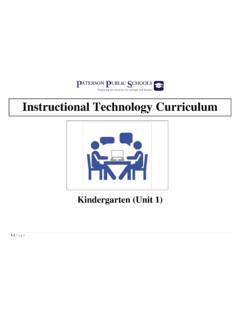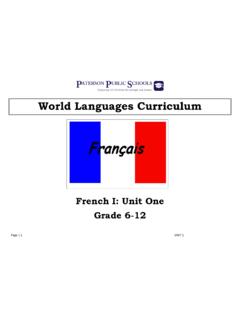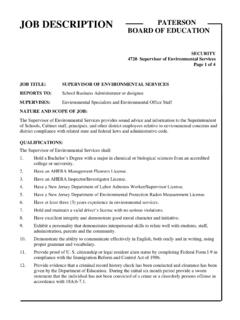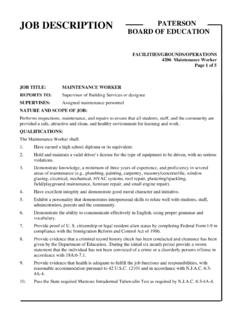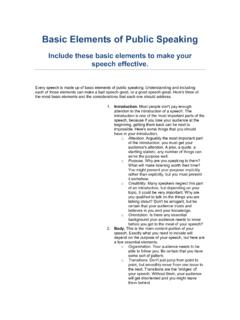Transcription of Public Speaking - Paterson Public Schools
1 1 | P a g e ] Public Speaking Grade 2: Unit 2 Title of Unit: The Communication Process 2 | P a g e ] Course Description (Workshop Model) Public Speaking is introduced to students in the second grade as an important component of their academic work and academic success. In addition, it is also introduced as an important component of their social lives. Students will be introduced to The Communication Process by demonstrating command of the conventions of Standard English grammar and usage when writing and or Speaking . Students will apply knowledge of language to understand how language functions in different contexts, to make effective choices for meaning or style, and to comprehend more fully when reading or listening.
2 Students will also acquire and use accurately a range of general academic and domain-specific words and phrases sufficient for reading, writing, Speaking , and listening. Students will demonstrate independence in gathering vocabulary knowledge when encountering an unknown term important to comprehension or expression. Students will prepare for and participate effectively in a range of conversations and collaborations with diverse partners, building on others ideas and expressing their own clearly and persuasively. Students will learn how to recount or describe key ideas or details from a text read aloud or information presented orally or through other media, ask and answer questions about what a speaker says in order to clarify comprehension, gather additional information, or deepen understanding of a topic or issue, and tell a story or recount an experience with appropriate facts and relevant, descriptive details, Speaking audibly in coherent sentences.
3 To make learning active, engaging, and responsive to students needs, a workshop model is employed. Teachers use the I Do, We Do, You Do instructional method. This model proactively supports student learning and develops their voices as Public speakers through teacher modeling, guided practice, and independent demonstration of learning or understanding. The second grade Public Speaking course and instruction builds on prior learning while supporting student achievement in Speaking and Listening. The Common Core Standards are designed to provide a clear understanding of what students are expected to learn so teachers and parents can take ownership in the education process. The standards are designed to be robust and relevant to the real world while reflecting on the knowledge and skills young learners need for future success in college and career readiness.
4 By providing a rigorous education that supports student achievement, we prepare them for a future where they can successfully compete in the global economy. It is our goal to establish a community of learners that become productive members of society striving to achieve their life-long goals. 3 | P a g e ] Rationale In order to plan instruction inclusive of all students in the Public Speaking classroom, a comprehensive curriculum has been developed. The standards covered during each instructional unit of the Public Speaking curriculum are reflective of the New Jersey Student Learning Standards outlined in the New Jersey Curriculum Framework. Speaking and Listening and language Standards have been unpacked to illustrate the critical knowledge and skills students need in order to master the standard.
5 Essential questions and sample activities are included to utilize when teaching such standard. 4 | P a g e ] Pacing Chart Unit 2 Topic: The Communication Process NJSLS Instruction: 7 weeks Assessment: 1 week Remediation/Enrichment: 1 week DISTRICT RESOURCES Textbook, The Basics of Speech: Learning to Be a Competent Communicator by Galvin & Cooper. Students will learn and practice the following in the Public Speaking Curriculum: Oral Communication (weekly vocabulary building) Elements of Communication Grammar Usage Articulation Pronunciation Verbal and Nonverbal Messages Channels of Communication Volume and Rate Body Movement Eye Contact Vocal Production (articulators, the palate, the diaphragmatic breathing) The learning objectives of Public Speaking are as follows: Students will improve vocabulary Students will understand oral communication Students will practice grammar usage Students will take part in articulation drills Students will practice pronunciation Students will become familiar with verbal and nonverbal messages in Reading Foundational Skills.
6 ,B,D ,B,C Speaking and Listening Standards: ,B,C, , , Language Standards: ,E,F, ,C,D,E , ,B,D,E, , 5 | P a g e ] Public Speaking Students will practice controlling their volume and rate while Speaking publicly Students will become more aware of their body movement while Speaking publicly Students will become aware of their eye contact with the audience while Speaking publicly Students will practice controlling their breathing Students will practice voice inflection 6 | P a g e ] Effective Pedagogical Routines/Instructional Strategies Collaborative problem solving Writing to learn Making thinking visible Note-taking Rereading & rewriting Establishing text-based norms for discussions & writing Establishing metacognitive reflection & articulation as a regular pattern in learning Quick writes Pair/trio Sharing Turn and Talk Charting Gallery Walks Whole class discussions Modeling Word Study Drills Flash Cards Interviews Role Playing Diagrams, charts and graphs Storytelling Coaching Reading partners Visuals Reading Aloud Model (I Do), Prompt (We Do), Check (You Do)
7 Mind Mapping Trackers Multiple Response Strategies Choral reading Reader s/Writer s Notebooks Conferencing Articulation Vocal Production Educational Technology Standards , , , , , , , , Technology Operations and Concepts Identify the basic features of a computer and explain how to use them effectively. Create a document using a word processing application. Compare the common uses of at least two different digital applications and identify the advantages and disadvantages of using each. Enter information into a spreadsheet and sort the information. Creativity and Innovation Illustrate and communicate original ideas and stories using multiple digital tools and resources. Communication and Collaboration Engage in a variety of developmentally appropriate learning activities with students in other classes, Schools , or countries using Various media formats such as online collaborative tools and social media.
8 Digital Citizenship Develop an understanding of ownership of print and non-print information. Research and Information Literacy Use digital tools and online resources to explore a problem or issue. Critical Thinking, Problem Solving, and Decision-Making Use geographic mapping tools to plan and solve problems. 7 | P a g e ] Computer Skills Basic Computer Skills Word Processing Skills sentences tween words and sentences lete to edit incorrect letters in body of text Keyboarding Skills Internet Skills Programs 8 | P a g e ] Career Ready Practices Standards CRP1, CRP2, CRP3, CRP4, CRP5, CRP6, CRP7, CRP8, CRP9, CRP10, CRP11, CRP12 CRP1. Act as a responsible and contributing citizen and employee Career-ready individuals understand the obligations and responsibilities of being a member of a community, and they demonstrate this understanding every day through their interactions with others.
9 They are conscientious of the impacts of their decisions on others and the environment around them. They think about the near-term and long-term consequences of their actions and seek to act in ways that contribute to the betterment of their teams, families, community and workplace. They are reliable and consistent in going beyond the minimum expectation and in participating in activities that serve the greater good. CRP2. Apply appropriate academic and technical skills. Career-ready individuals readily access and use the knowledge and skills acquired through experience and education to be more productive. They make connections between abstract concepts with real-world applications, and they make correct insights about when it is appropriate to apply the use of an academic skill in a workplace situation CRP3.
10 Attend to personal health and financial well-being. Career-ready individuals understand the relationship between personal health, workplace performance and personal well-being; they act on that understanding to regularly practice healthy diet, exercise and mental health activities. Career-ready individuals also take regular action to contribute to their personal financial wellbeing, understanding that personal financial security provides the peace of mind required to contribute more fully to their own career success. CRP4. Communicate clearly and effectively and with reason. Career-ready individuals communicate thoughts, ideas, and action plans with clarity, whether using written, verbal, and/or visual methods. They communicate in the workplace with clarity and purpose to make maximum use of their own and others time.
